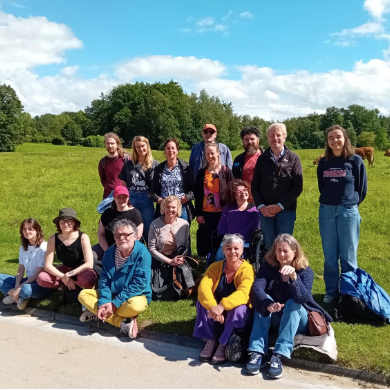Riina Kalmis greetings from Belgium
Published on — Written by Riina Kalmi
In April, I received an email from the Regional Dance Centre in Ostrobothnia asking whether I would like to take on a representative assignment in Belgium. After a short moment of consideration, I said yes—and by May, I was already on my way!
The purpose of the trip was to participate in the international Erasmus+ project IDEA, whose core themes are inclusivity, participation, and equal agency. The project aims to explore cultural actors in Belgium, France, and Finland from the perspective of inclusion and to study the theme (to quote the project description) “third type spaces for inclusive cultural practice and economical activities, with a special interest, but not exclusively, for artists with disabilities.” It also seeks to provide opportunities for the exchange of professional skills and experiences among cultural practitioners.
Our first joint meeting was held in Genappe. The week included several inspiring visits to so-called third type spaces. One of the greatest lessons from these visits was the importance of collaboration. Each project involved multiple partners united by shared values, goals, and a common space. Sharing, openness, and collective action were visible both in thinking and in practice—for example, through accessible art workshops, free concerts, or themed discussion evenings.
The term “third type space” was unfamiliar to me beforehand. It refers to a space where people spend time between home and work. I still need to study the concept further. But my experience was that each project stemmed from a desire to do something good for the benefit of all—and it was truly inspiring to witness that!
The most memorable day for me was our visit to a residential unit for people with intellectual disabilities and our introduction to an inclusive project called L’Essentiel. Behind the project is a non-profit organization whose goal is to support adults with disabilities—regardless of the type or degree of disability—in their daily lives and personal development. L’Essentiel provides a home for about 30 residents. The number of inhabitants grows, of course, when you count the goats, rabbits, chickens, and horses that live there—and who were very eager to meet new visitors. Horse therapy is one of the activities offered to the residents of L’Essentiel. In addition to the therapeutic aspect, the presence of horses and other animals brought a sense of responsibility. The daily duties included caring for, feeding, and maintaining the animals and their surroundings. As an animal lover, I have to say—I wish animals were a more present part of everyone’s everyday life!
Alongside the animals, daily activities also included art workshops such as painting, pottery, theatre, dance, physical exercise, and studying. In addition, L’Essentiel offered residents the opportunity to work. Equal rights to employment are still, unfortunately, far from being realized for everyone. This is something that L’Essentiel seeks to change—so that every person who wishes can work, earn an income, and thereby be part of society.
Our day concluded with a visit to the Folon Museum. Jean-Michel Folon was a Belgian artist, illustrator, painter, and sculptor. The museum route, designed by Folon himself, winds through an original, poetic, and interactive exhibition composed of installations—plays of light, music, and optical effects. Our guide was Jason, a resident of L’Essentiel. Folon aimed to create a universal language through his art, one that could speak to everyone. The central themes of his work were human rights, humanity, and the equal right to life.
After the visit, I found myself reflecting on how, even though we often talk about human rights and equality, how much do we, as humankind, actually do to advance them? We live in a world full of exclusionary structures and ways of thinking. Often these remain hidden within normalized practices—so ordinary that they go unnoticed and unquestioned. Inclusivity can be understood as the process of dismantling those structures and thought patterns, and as the realization that we are already all part of the whole—if, as a community, we choose to see and act that way.
Art and dance have the potential to create spaces for encounters—encounters where everyone has value in their own way. Hopefully, in the future, everyone who wishes will have the opportunity and the freedom to express themselves through their body—as equals.
—
Category:
Uutiset

